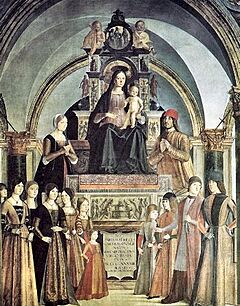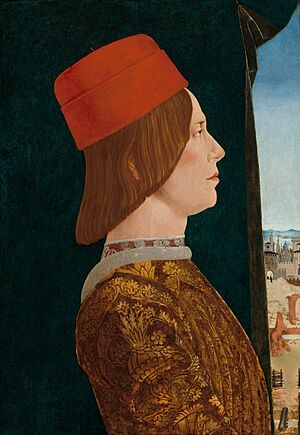Giovanni II Bentivoglio facts for kids
Giovanni II Bentivoglio (born February 12, 1443 – died February 15, 1508) was an important Italian nobleman. He ruled the city of Bologna from 1463 until 1506. Even though he didn't have a formal title like "king," he was the most powerful person in Bologna, acting as its "first citizen." His family, the Bentivoglio family, had been powerful in Bologna since 1443. They often tried to make their control over the city's government, called the Signoria, even stronger.
Contents
Early Life and Family
Giovanni II was born in Bologna. His father was Annibale I Bentivoglio, who was a chief leader of the city. His mother was Donnina Visconti. When Giovanni was a young child, his father was sadly killed by a rival in 1445.
After his father's death, a man named Sante I took over the rule of Bologna. Sante was thought to be a cousin of Giovanni's father. Sante had been an apprentice in the wool business in Florence before he became the leader of Bologna in 1443. When Sante died in 1463, Giovanni II Bentivoglio successfully became the new ruler of the city. Bologna was technically under the control of the Pope, but Giovanni held the real power. In 1464, Giovanni married Sante's widow, Ginevra Sforza. The Pope also gave Giovanni the special right to be the permanent head of Bologna's Senate.
Giovanni's Rule in Bologna
To make sure other powerful families in Italy supported him, Giovanni sometimes fought as a condottiero, which was a leader of soldiers for hire. In 1467, he helped Florence, Milan, and Naples in a fight. Later, in 1471, he helped Milan again. His first real military actions happened in 1477 when he attacked the city of Faenza. In 1482, he helped Ercole I d'Este against the Pope and Venice during a war. He also fought in smaller conflicts for the Kingdom of Naples. However, his direct involvement in battles was often limited by the rules of Bologna.
In 1488, Giovanni faced a difficult situation when his daughter, Francesca, was involved in the death of her husband, Galeotto Manfredi, who ruled Faenza. The people of Faenza thought this was a trick to take over their city and they rebelled. When Giovanni went to Faenza to stop the revolt, he was captured. He was only set free with help from Lorenzo de' Medici, a powerful leader from Florence. In the same year, Giovanni was made the Chief of Staff for the Milanese army. This was mostly an honorary title, as Giovanni let his sons handle the actual command duties. Also in 1488, Giovanni had to stop a plot against him by the Malvezzi family. Most of the family members were either executed or sent away. In 1501, a similar event happened with the Marescotti family.
Giovanni Bentivoglio managed to resist the growing power of Cesare Borgia for a while. However, on October 7, 1506, Pope Julius II declared that Giovanni was no longer the ruler and was no longer part of the church. The Pope also placed Bologna under a ban, meaning no church services could happen there. When the Pope's army, along with soldiers from Louis XII of France, marched towards Bologna, Giovanni and his family fled. Pope Julius II then entered the city in triumph on November 10.
Giovanni first went to Busseto to stay with the Pallavicino family. In 1507, his sons, Annibale II and Ermes, tried to take Bologna back, but they failed. After this, the people of Bologna rioted and destroyed Giovanni's palace in the city.
Giovanni died as a prisoner of Louis XII in Milan in 1508. He passed away in the Castello Sforzesco in that city.
Bologna's Beauty and Art
Giovanni II Bentivoglio ruled for almost 50 years. During his time, he kept a grand court and made Bologna more beautiful. He especially improved the city's waterways. However, while the city and its celebrations were splendid, many poor people in Bologna faced hardship.
Giovanni ordered many art projects. One important project was the frescoes (wall paintings) showing the life of Saint Cecilia in the Oratorio di Santa Cecilia. These paintings were created by famous artists living in Bologna at the time, including Francesco Francia, Lorenzo Costa the Elder, and Amico Aspertini.
Another important artwork was the Bentivoglio Altarpiece by Lorenzo Costa. This painting is in the Bentivoglio Chapel inside the church of San Giacomo Maggiore. Giovanni Bentivoglio ordered this painting as a way to thank God for his family surviving an attempt by the Malvezzi family to harm them. Giovanni also had the Palazzo Bentivoglio (which was like a city hall) built starting in 1498. The architect G. Nadi designed it. Another Bolognese architect, Aristotile Fioravanti, who later moved to Russia, made plans to rebuild the Palazzo del Podestà. Giovanni had this reconstruction done between 1484 and 1494.
Giovanni's Family
On May 2, 1464, Giovanni married Ginevra Sforza (1440–1507). She was the daughter of Alessandro Sforza, a lord from Pesaro, and she was also the widow of Giovanni's cousin, Sante Bentivoglio. Ginevra was an important advisor to Giovanni. She had sixteen children with Giovanni, but five of them died when they were very young. Their other children included:

- Annibale II Bentivoglio (1469–1540): He married Lucrezia, the daughter of Ercole I d'Este. Annibale II was the lord of Bologna from 1511 to 1512.
- Ermes Bentivoglio (1475–1513)
- Alessandro Bentivoglio (1474–1532): He married Ippolita Sforza.
- Camilla: She became a nun.
- Isotta: She also became a nun.
- Francesca: She married Galeotto Manfredi.
- Antongaleazzo Bentivoglio: He was a church official.
- Eleonora
- Laura: She was the wife of Giovanni Gonzaga.
- Violante: She was the wife of Pandolfo IV Malatesta.
- Bianca
Giovanni also had another daughter named Camilla Bentivoglio. Her mother was said to be a 'Lucrezia D'Este'. This Camilla married Pirro Gonzaga, who was from the House of Gonzaga. Camilla and Giovanni are ancestors of important people today, including Henri, Grand Duke of Luxembourg and King Philippe of Belgium.


